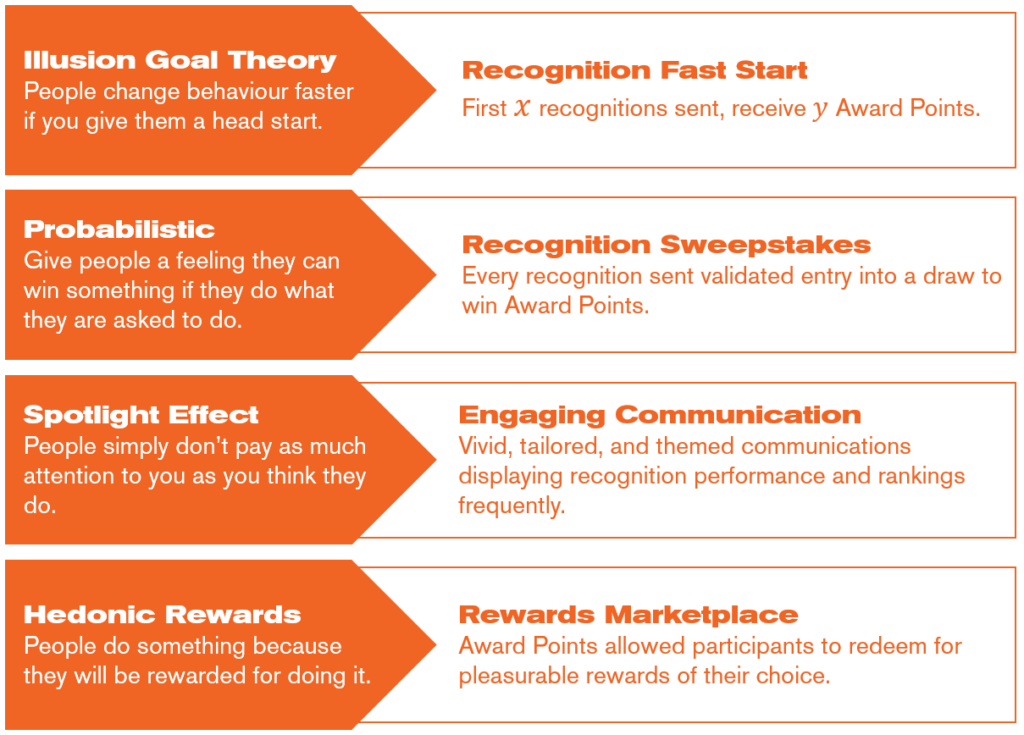Impact
The team was triggered to quickly embrace the program in ways that fit their organisation’s culture, earning rewards that mattered to them — resulting in the desired ‘re-engagement’ within a few short weeks.
Industry
Telecommunications
Problem space
Employee engagement
Services
Communications
Recognition
Rewards
Technology
DayMaker
Employee recognition is about much more than simply creating a workplace feel-good factor. There is an abundance of research demonstrating the impact regular and meaningful recognition can have on productivity, profitability, quality, and sales growth.
- Engaged employees have 18% higher productivity and 60% higher quality than under-engaged employees (Insync Surveys)
- Companies in the top quartile of engagement scores had 50% higher total shareholder return than the average company (Aon Hewitt)
- A study of Fortune 100 companies revealed a 1,000% increase in errors among disengaged versus engaged populations (Journal of Business Strategy)
- Each incremental percentage of employees who become engaged predicts an incremental 0.6% growth in sales (AON Hewitt)
A telecommunications client put this to the test by implementing a robust recognition strategy.
Challenge
Manager and employee engagement and recognition activity continued to decline over a sustained period, impacting staff satisfaction, turnover, culture, and productivity. The company needed to lift engagement and develop a culture of recognition, specifically within the retail department. It was seen as a re-engagement strategy.
Solution
A comprehensive strategy of employee engagement and recognition solutions, backed by behavioural science and offering motivating rewards. Each aspect of the program linked to specific principles in behavioural economics that have been proven effective through our many years of research.
Several key behavioural principles were applied to this program, including those detailed below:

Research shows employees are motivated when they feel appreciated and recognised for their contributions in ways that matter to them. The key is applying a human-centric design focus, exploring the real needs of employees and how they interact within the organisation. Successful engagement initiatives also recognise the importance of involving managers and team leaders as key stakeholders in the program. Managers are essential in supporting meaningful sustained cultural shifts to inspire teams and drive the innovation that leads to measurable business results. Middle managers, in particular, can have a dramatic impact on organisational culture through their direct involvement in the daily lives of their teams.
In this case, managers were given the flexibility to publicly recognise and reward employees at their own discretion — both via the platform issuing awards points and outside the platform using On The Spot cards (branded physical cards pre-loaded with awards points).
Results
Leveraging our extensive knowledge in behavioural science ensured the initiatives had a high chance of success. The team was triggered to quickly embrace the program in ways that fit their organisation’s culture, earning rewards that mattered to them — resulting in the desired ‘re-engagement’ within a few short weeks.
- 500% lift in recognitions
- 300% increase in the average daily logins
- 100% of managers frequently sent recognition
- Retail department became the top-performing department in unique recognitions sent
The good news didn’t stop there. The cultural shift brought about by this strategic recognition initiative led to immediate business improvement.
- $130,000 in business savings
- Team member engagement improved by 65%
- 3% reduction in 30 day first call resolution results
- 2% reduction in 10 day first call resolution results
- 6,000 fewer customer calls



